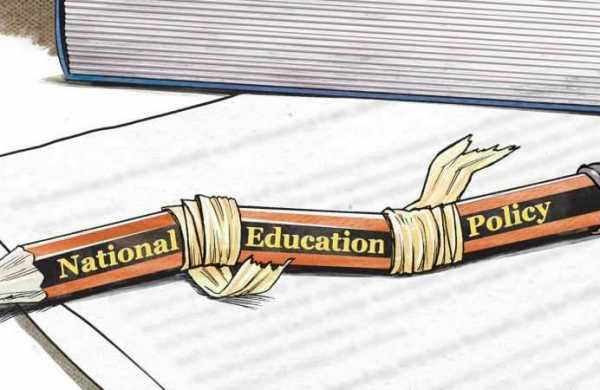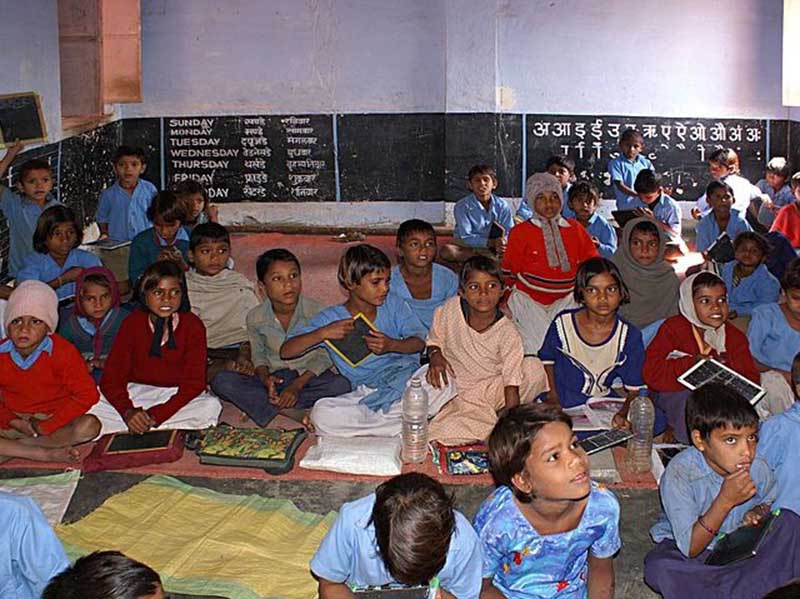By Prof. Gourav Vallabh, first published in The New Indian Express

We should also not miss out on real issues like poor infrastructure, poor research facilities, shortage of teachers, unhealthy government schools. ( Express illustration)
The National Education Policy (NEP) 2020, from a birds-eye view, looks promising: The schooling years are divided into several sections with programme outcomes specified for each level. It talks about focus on discovery, preparation, abstract thinking and multidisciplinary learning and that with technology redefining probably everything around us, the concept of education must also be revamped to meet the needs of the learners today.
However, before one jumps to applauding the NEP, one requires a deep dive into the current challenges that India’s education system faces at the grassroots level—the issue of bringing kids to school, retaining students (especially girls) in school, enabling teachers to deliver the NEP-imagined curriculums, creating and enabling sufficient technological infrastructure, delivering the committed education budgets and ensuring that every educated Indian is employable.
What we need to further question is if this NEP,
- sufficiently addresses the above challenges,
- has a well-defined implementation roadmap and milestones,
- has critical finances for execution of this grand vision,
- ensures that it will not exacerbate the current educational divide between the marginalised and the privileged, and the rural and the urban children. Moreover, there is a severe dearth of trained personnel in the country. Not to forget the unfortunate situation that the teachers of today are also the products of the current education system—and hence we need a system that equips knowledge facilitators to understand the nuances of this novel ecosystem. Interestingly, the NEP relies upon anganwadi workers, already overburdened with numerous public health and nutrition duties, for delivering quality “Early Childhood Care and Education” (ECCE).
To train them to meet ECCE standards through six-month diploma courses would itself be a Herculean task. Over 10 lakh vacancies are still open at the school level, leave alone the matter of several insufficiently skilled PGTs and TGTs. Moreover, conditions in anganwadi centers remain abysmally poor. Figures from December 2019 show that over 3 lakh anganwadi centers don’t have proper toilets and over 1.5 lakh lack potable drinking water. Can they be expected to meet and deliver the ambitious ECCE quality targets set by the NEP? The provision to provide multidisciplinary study options cannot be implemented in rural schools where the student-teacher ratio is too high.
This has to be facilitated with heavy funds and infrastructure coupled with a large teaching faculty. The ‘good to have’ modern pedagogies, values, skills, and learning methods were already present in the National Curriculum Framework of 2005. The policy also covers alternate curriculum subjects like yoga, Indian philosophy and Adivasi/indigenous ways of learning in the syllabus. But upskilling teachers, who presently struggle even to teach the basic syllabus at the primary level, is not easy.
The NEP also lays focus on digital and distance learning to increase gross enrolment ratio from 26% to over 50%. However, the primary reasons for dropping out of school such as child marriage and child labor remain unaddressed in the policy. It also lacks clarity about the employability value of the open learning courses. The absence of digital infrastructure will lead to the further segregation of the poor and disadvantaged, creating a “digital divide” that will grow even stronger due to the absence of or limited internet connectivity/access to technology in rural areas.
As per UDISE+ (Unified District Information on School Education, Department of School Education, Government of India), only 9.85% of government schools have a functional computer and 4.09% have an internet connection. This itself puts into question the overwhelming reliance on online education in NEP 2020. The NEP recommends a spending of 6% of GDP on education. However, spending on education has fallen from 4.14% in 2014-15 to 3.2% in 2020-21 under the BJP regime. Even this amount may get cut down by 40% owing to the coronavirus pandemic in the current year, bringing the education spending to just 2% of the total budget. There is hence no clarity on whether the NEP proposes financing of 6% of GDP to come from public funds or private investments.
The fear is that such unstructured commitments may further privatize, commercialize and overly centralize education, thus taking away the autonomy from well-functioning institutes, and also lead to sudden fee hikes and reduction in employment security of the academic staff. As a nation aiming for a humongous $5 trillion economy, the NEP has to set the course right in attaining the educational goals. We need to rebuild our universities rather than inviting universities from other countries, improve our own research infrastructure, create a strong ecosystem of learning, unlearning and relearning—coupled with inculcating a culture of critical thinking, innovation and research.
This should be so systematically executed that it ensures India reclaims its rightful place in the mantle of world education. We should also not miss out on real issues like poor infrastructure, poor research facilities, shortage of teachers, unhealthy government schools and high number of student dropouts. The education policy has to act as a stepping stone towards reclaiming the pedestal India has lost—as a country with thinkers, philosophers, mathematicians, scientists—and not as a distraction to sway people away from the real issues in education.
Disclaimer: The opinions expressed within this article are the personal opinions of the author. AlignIndia does not take any responsibility for the content of the article.
Prof. Gourav Vallabh (gourav.vallabh@gmail.com, @GouravVallabh) is National Spokesperson, Congress, and Professor of Finance, XLRI, Jamshedpur.
First published in https://www.newindianexpress.com/opinions/2020/aug/12/does-the-national-education-policy-miss-out-on-real-issues-2182273.html


